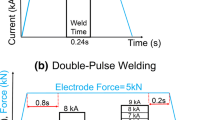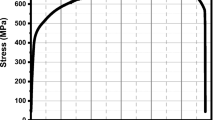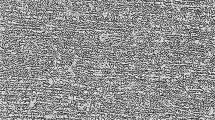Abstract
In situ post weld heat treatment (PWHT) by applying a second pulse current during resistance spot welding (RSW) provides a new pathway to alter the microstructure of the fusion zone (FZ) and improves the mechanical performance of the RSW joint. In the present study, effect of the second pulse current on microstructural characteristics and mechanical performance of resistance spot weld joint of HSLA350 steel under were investigated. It was observed that after applying the second pulse current during welding process, it subdivides the initial solidified fusion zone into two zones, namely equiaxed grain zone (EGZ) and columnar grain zone (CGZ). The outer layer becomes EGZ consisting of quasi-equiaxed grains of ferrite and martensite whereas the inner core is CGZ solidified with a columnar grain structure consisting of martensite and some bainite. The refinement of microstructure in the case of double pulse weld resulted in enhanced tensile shear strength and failure energy absorption capacity with ductile pullout failure mode.















Similar content being viewed by others
References
Keeler S, Kimchi M, Mconey PJ (2017) Advanced High-Strength Steels Application Guidelines. Version 6.0. World Auto Steel, April 2017
Hilditch TB, de Souza T, Hodgson PD (2015) Properties and automotive applications of advanced high-strength steels (AHSS). In: Welding and joining of advanced high strength steels (AHSS). Woodhead Publishing, pp 9-28. doi:https://doi.org/10.1016/b978-0-85709-436-0.00002-3
Park D-B, Huh M-Y, Shim J-H, Suh J-Y, Lee K-H, Jung W-S (2013) Strengthening mechanism of hot rolled Ti and Nb microalloyed HSLA steels containing Mo and W with various coiling temperature. Mater Sci Eng A 560:528–534. https://doi.org/10.1016/j.msea.2012.09.098
Pouranvari M, Marashi SPH (2011) Failure mode transition in AHSS resistance spot welds. Part I. Controlling factors. Mater Sci Eng A 528(29-30):8337–8343. https://doi.org/10.1016/j.msea.2011.08.017
Pouranvari M, Marashi SPH (2013) Key factors influencing mechanical performance of dual phase steel resistance spot welds. Sci Technol Weld Join 15(2):149–155. https://doi.org/10.1179/136217109x12590746472535
Pouranvari M, Mousavizadeh SM, Marashi SPH, Goodarzi M, Ghorbani M (2011) Influence of fusion zone size and failure mode on mechanical performance of dissimilar resistance spot welds of AISI 1008 low carbon steel and DP600 advanced high strength steel. Mater Des 32(3):1390–1398. https://doi.org/10.1016/j.matdes.2010.09.010
Pouranvari M, Hoveida Marashi SP, Jaber HL (2015) DP780 dual-phase-steel spot welds: critical fusion-zone size ensuring the pull-out failure mode. Mater Tehnol 49(4):579–585. https://doi.org/10.17222/mit.2014.184
Society AW (2002) Recommended practices for test methods for evaluating the resistance spot welding behavior of automotive sheet steel materials D8.9M. AWS/ANSI/SAE
Pouranvari M, Marashi SPH, Safanama DS (2011) Failure mode transition in AHSS resistance spot welds. Part II: Experimental investigation and model validation. Mater Sci Eng A 528(29-30):8344–8352. https://doi.org/10.1016/j.msea.2011.08.016
Pouranvari M, Ranjbarnoodeh E (2013) Failure mode of HSLA/DQSK dissimilar steel resistance spot welds. Ironmak Steelmak 40(4):276–281. https://doi.org/10.1179/1743281212y.0000000044
Pouranvari M, Asgari HR, Mosavizadch SM, Marashi PH, Goodarzi M (2013) Effect of weld nugget size on overload failure mode of resistance spot welds. Sci Technol Weld Join 12(3):217–225. https://doi.org/10.1179/174329307x164409
Sajjadi-Nikoo S, Pouranvari M, Abedi A, Ghaderi AA (2017) In situ postweld heat treatment of transformation induced plasticity steel resistance spot welds. Sci Technol Weld Join 23(1):71–78. https://doi.org/10.1080/13621718.2017.1323174
Chabok A, van der Aa E, De Hosson JTM, Pei YT (2017) Mechanical behavior and failure mechanism of resistance spot welded DP1000 dual phase steel. Mater Des 124:171–182. https://doi.org/10.1016/j.matdes.2017.03.070
Eftekharimilani P, van der Aa EM, Hermans MJM, Richardson IM (2017) Microstructural characterisation of double pulse resistance spot welded advanced high strength steel. Sci Technol Weld Join 22(7):545–554. https://doi.org/10.1080/13621718.2016.1274848
Chabok A, van der Aa E, Basu I, De Hosson J, Pei Y (2018) Effect of pulse scheme on the microstructural evolution, residual stress state and mechanical performance of resistance spot welded DP1000-GI steel. Sci Technol Weld Join 23(8):649–658. https://doi.org/10.1080/13621718.2018.1452875
Hernandez VB, Okita Y, Zhou Y (2012) Second pulse current in resistance spot welded TRIP steel—effects on the microstructure and mechanical behavior. Weld J 91:278–285
Liu XD, Xu YB, Misra RDK, Peng F, Wang Y, Du YB (2019) Mechanical properties in double pulse resistance spot welding of Q&P 980 steel. J Mater Process Technol 263:186–197. https://doi.org/10.1016/j.jmatprotec.2018.08.018
Zhong N, Liao X, Wang M, Wu Y, Rong Y (2011) Improvement of microstructures and mechanical properties of resistance spot welded DP600 steel by double pulse technology. Mater Trans 52(12):2143–2150. https://doi.org/10.2320/matertrans.M2011135
Pouranvari M, Aghajani H, Ghasemi A (2019) Enhanced mechanical properties of martensitic stainless steels resistance spot welds enabled by in situ rapid tempering. Sci Technol Weld Joining 1-8. doi:https://doi.org/10.1080/13621718.2019.1641962
Nikoosohbat F, Kheirandish S, Goodarzi M, Pouranvari M, Marashi SPH (2013) Microstructure and failure behaviour of resistance spot welded DP980 dual phase steel. Mater Sci Technol 26(6):738–744. https://doi.org/10.1179/174328409x414995
Sawanishi C, Ogura T, Taniguchi K, Ikeda R, Oi K, Yasuda K, Hirose A (2013) Mechanical properties and microstructures of resistance spot welded DP980 steel joints using pulsed current pattern. Sci Technol Weld Join 19(1):52–59. https://doi.org/10.1179/1362171813y.0000000165
Duan R, Luo Z, Li Y, Zhang Y, Liu ZM (2014) Novel postweld heat treatment method for improving mechanical properties of resistance spot weld. Sci Technol Weld Join 20(2):100–105. https://doi.org/10.1179/1362171814y.0000000262
Pouranvari M (2013) Failure mode transition in similar and dissimilar resistance spot welds of HSLA and low carbon steels. Can Metall Q 51(1):67–74. https://doi.org/10.1179/1879139511y.0000000020
Khan MS, Bhole SD, Chen DL, Biro E, Boudreau G, van Deventer J (2013) Welding behaviour, microstructure and mechanical properties of dissimilar resistance spot welds between galvannealed HSLA350 and DP600 steels. Sci Technol Weld Join 14(7):616–625. https://doi.org/10.1179/136217109x12464549883295
Yurioka N (2004) Comparison of preheat predictive methods. Weld World 48(1-2):21–27
Jaber HL, Pouranvari M, Salim RK, Hashim FA, Marashi SPH (2016) Peak load and energy absorption of DP600 advanced steel resistance spot welds. Ironmak Steelmak 44(9):699–706. https://doi.org/10.1080/03019233.2016.1229880
Pouranvari M, Marashi SPH (2013) Failure of resistance spot welds: tensile shear versus coach peel loading conditions. Ironmak Steelmak 39(2):104–111. https://doi.org/10.1179/1743281211y.0000000066
Gould J, Khurana S, Li T (2006) Predictions of microstructures when welding automotive advanced high-strength steels. Weld J-New York 85(5):111
Bose-Filho WW, Carvalho ALM, Strangwood M (2007) Effects of alloying elements on the microstructure and inclusion formation in HSLA multipass welds. Mater Charact 58(1):29–39. https://doi.org/10.1016/j.matchar.2006.03.004
Pouranvari M (2013) On the failure mode of resistance spot welded HSLA 420 steel. Arch Metall Mater 58(1):67–72. https://doi.org/10.2478/v10172-012-0152-y
Pouranvari M, Marashi SPH, Mousavizadeh SM (2011) Dissimilar resistance spot welding of DP600 dual phase and AISI 1008 low carbon steels: correlation between weld microstructure and mechanical properties. Ironmak Steelmak 38(6):471–480. https://doi.org/10.1179/1743281211Y.0000000024
Acknowledgments
The author thanks Bloxwich Sdn Bhd Malaysia for providing material for the present study.
Funding
This work was supported by the Universiti Teknologi PETRONAS Malaysia Grant URIF 0153AA-G23.
Author information
Authors and Affiliations
Corresponding author
Ethics declarations
Conflict of interest
The authors declare that they have no conflict of interest.
Additional information
Publisher’s note
Springer Nature remains neutral with regard to jurisdictional claims in published maps and institutional affiliations.
Rights and permissions
About this article
Cite this article
Soomro, I.A., Pedapati, S.R. Application of in situ post weld heat treatment using double pulse technology and its effect on microstructure and mechanical performance of resistance spot welded HSLA350 steel. Int J Adv Manuf Technol 105, 3249–3260 (2019). https://doi.org/10.1007/s00170-019-04569-2
Received:
Accepted:
Published:
Issue Date:
DOI: https://doi.org/10.1007/s00170-019-04569-2




